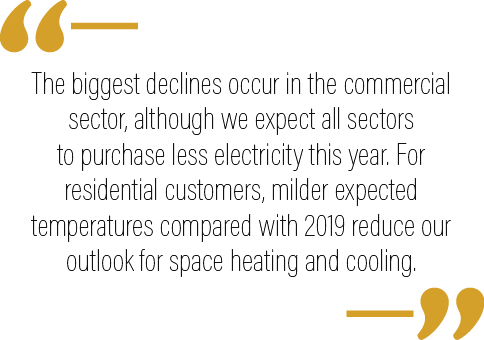By The Utah Petroleum Association
The Deputy Administrator, U.S. Energy Information Administration, U.S. Department of Energy, Stephen Nalley, delivered a statement to the Energy and Natural Resources Committee of the U.S. Senate on June 16, 2020. While the assessment of the energy sector continues to evolve and more recent updates can be found in the EIA monthly and weekly update reports, we wanted to share Mr. Nalley’s high level summary of the impacts of COVID-19 on the energy sector.
Chairman Murkowski, Ranking Member Manchin, and Members of the Committee, I appreciate the opportunity to testify about the U.S. Energy Information Administration’s (EIA) assessment of the effects the 2019 novel coronavirus disease, or COVID-19, has had on energy markets. My testimony reflects EIA’s latest assessment and forecast as published in our June Short-Term Energy Outlook.
Even during less challenging times, market outlooks like our Short-Term Energy Outlook are subject to many uncertainties. Because we update the Outlook monthly, recent editions have reported significant changes in energy markets as we learn more about the evolving effects of mitigation efforts related to COVID-19. Reduced domestic and worldwide economic activity have resulted in unprecedented changes in energy supply and demand patterns. We will continue to study these effects and report what we learn in our monthly updates.
This month’s Outlook reflects a forecast decline in U.S. gross domestic product of 7.4% in 2020, largely related to continued mitigation efforts related to COVID-19. Because EIA focuses solely on energy issues, we are not in a position to generate a broader macroeconomic forecast, and we have long used IHS Markit forecasts as the basis of our U.S. gross domestic product forecast and Oxford Economics forecasts for global gross domestic product.
As a result of the effects of travel restrictions and stay-at-home orders on the U.S. economy, EIA forecasts that domestic consumption of petroleum liquids, will decrease, with gasoline consumption falling by nearly 13% in 2020 and diesel decreasing about 10%. We believe that the most significant declines in domestic consumption of petroleum liquids have already occurred and consumption will grow over the next 18 months. Nevertheless, we do not expect to see a return to 2019 consumption levels by the end of 2021. Similarly, global consumption of petroleum and liquid fuels will decrease by more than 8 million barrels per day in 2020, with most of the decrease having already occurred during the second quarter of this year.
U.S. crude oil production, which reached an all-time high of 12.9 million barrels per day in November 2019, had fallen by 1.5 million barrels per day as of May 2020. We expect to see a continued decline in U.S. crude oil production until March of next year. Globally, we forecast that supply will fall by almost 6 million barrels per day in 2020. The decrease in non-U.S. supply is mainly the result of voluntary cuts by the Organization of the Petroleum Exporting Countries, or OPEC, and its partner countries.
Given these changes in demand and supply, we expect that global liquid fuels inventories will grow by an average of 2.2 million barrels per day in 2020. We estimate that inventory builds peaked during April, which was the result of a sharp decline in global oil demand because of widespread travel limitations and reduced economic activity.
The Brent crude oil price averaged $29 per barrel in May, $11 per barrel higher than in April as a result of a number of OPEC producers that deepened their production cuts beyond the initial April 12 agreement to voluntarily decrease production. We expect that monthly Brent crude oil prices will average $37 per barrel during the second half of 2020 and rise to an average of $48 per barrel in 2021. Although large inventories and spare crude oil production capacity will temper prices during the coming months, we expect upward price pressures will increase as inventories decline into 2021.
Beyond crude oil and liquid fuels, reduced economic activity related to COVID-19 mitigation efforts has had far-reaching effects on natural gas and electricity markets in the United States and globally.
We expect to see both natural gas consumption and production in the United States decline in 2020, with consumption declining by about 4% and production falling by nearly 3%. Despite our forecast of a recovery in 2021, we do not expect U.S. production and consumption to return to 2019 levels. Reduced manufacturing activity in the United States, along with lower exports of liquefied natural gas, have lowered our forecast of U.S. consumption in 2020. Weaker natural gas demand will keep prices relatively low in 2020, but we expect that rising demand into next winter, in the face of lowered production, will exert upward pressure on natural gas prices at the end of 2020 and into next year. We forecast that the U.S. benchmark Henry Hub natural gas spot price will rise to an average of $3.08 per million British thermal units in 2021, compared with $1.75 per million British thermal units in May of this year.

In our June Outlook, we reported 5.7% less electricity consumption in the United States in 2020 than in 2019. The biggest declines occur in the commercial sector, although we expect all sectors to purchase less electricity this year. For residential customers, milder expected temperatures compared with 2019 reduce our outlook for space heating and cooling. These milder temperatures more than offset increased use of residential electricity as more people work and spend more time at home while social distancing guidelines remain in place. We forecast retail electricity prices for all the residential sector to increase slightly, while the commercial and industrial sector retail electricity prices will fall by about 1% in 2020.
Our Outlook also reports that U.S. coal production will fall by 25% in 2020, the result of both decreasing demand for U.S. coal exports and declining coal-fired electric power generation in the United States. Metallurgical coal mines in Appalachia have slowed production as a result of reduced demand for coking coal for global steel production, while production in the West declines, in part, because of slowing demand for steam coal from key importers such as India.
In addition to our Short-Term Energy Outlook, we have published new analysis and data products to improve the public’s understanding of energy markets during the COVID-19 pandemic. For example, changes in petroleum product demand and relatively slower changes in crude oil production led to rapid increases in U.S. petroleum inventories in March and April. This sudden increase quickly diminished available crude oil storage capacity in the United States and caused concern among market participants, which added to uncertainty in the market. In response to these concerns, including those shared by Chairman Murkowski in her letter to the EIA Administrator on March 31, in early April, EIA began to track and update U.S. crude oil storage utilization in a Weekly U.S. and Regional Crude Oil Stocks and Working Storage Capacity report.
We have also published a number of articles in our Today in Energy series that explain how information in various EIA products can help the public understand what is happening in energy markets. These articles include in-depth explanations of key petroleum data products, such as the Weekly Petroleum Status Report and the Gasoline and Diesel Fuel Update. We also published articles on natural gas and electricity, including articles on the Weekly Natural Gas Storage Report and the Hourly Electric Grid Monitor.
We will continue to monitor events in energy markets globally and continue to update our monthly short-term forecast to reflect our developing understanding of the effects of the mitigation efforts related to COVID-19 on the energy economy.
Chairman Murkowski, Ranking Member Manchin, and Members of the Committee, thank you for the opportunity to present this information, and this concludes my testimony.
The Utah Association of Petroleum
The Deputy Administrator, U.S. Energy Information Administration, U.S. Department of Energy, Stephen Nalley, delivered a statement to the Energy and Natural Resources Committee of the U.S. Senate on June 16, 2020. While the assessment of the energy sector continues to evolve and more recent updates can be found in the EIA monthly and weekly update reports, we wanted to share Mr. Nalley’s high level summary of the impacts of COVID-19 on the energy sector.
This story appears in Pub 1 2019-20 Issue 4 of the UPDATE Magazine.









